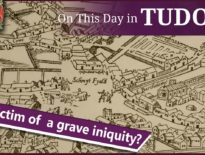On this day in Tudor history, 19th December 1583, twenty-three-year-old convicted conspirator, John Somerville, was found dead in his cell at Newgate Prison. His death was said to be suicide, due to his poor mental health, but some Catholics believed that he had been killed.
Somerville had been found guilty of conspiring to assassinate the queen, but did he really mean to? Was he mentally ill? Was he manipulated by others?
Find out more about John Somerville in today's talk.
Also on this day in Tudor history, 19th December 1576, Katherine Palmer, Abbess of Syon, died in Belgium. Her death came just over a month after she had confronted a mob that had broken into her monastery. Find out more about Abbess Katherine Palmer, how her order had ended up settling in Belgium, and how her order is the only surviving pre-Reformation religious community in England today, in last year’s video:
Also on this day in history:
- 1562 – The Battle of Dreux between Catholics, led by Anne de Montmorency, and Huguenots, led by Louis I, Prince of Condé, during the first war of the French Wars of Religion. The Catholics were victorious, but both commanders were taken prisoner.
- 1578 (19th or 26th December) – Executions of Egremont Radcliffe and a man called Gray at Namur in Belgium. They were beheaded in the marketplace after being suspected of poisoning Don John of Austria.
- 1587 – Death of Thomas Seckford, lawyer and administrator, at Clerkenwell in Middlesex. He was buried at Clerkenwell, but then moved to the family vault at Woodbridge in Suffolk. Seckford served Mary I as Deputy Chief Steward of the Duchy of Lancaster and Elizabeth I as Master of Requests and Steward of the Marshalsea court.
Transcript:
On this day in Tudor history, 19th December 1583, twenty-three-year-old convicted conspirator, John Somerville, was found dead in his cell at Newgate Prison. Death was by strangulation, and it was said to be suicide. His body was buried in Moorfields, and his head was put on display on London Bridge.
Let me tell you more about Somerville, the conspiracy he was accused of being involved in, and his death…
• John Somerville was born in 1560 and was the son of John Somerville of Edstone in Warwickshire, and his wife, Elizabeth Corbett.
• Somerville was educated at Hart Hall, Oxford.
• In 1579, following the death of his father, Somerville inherited properties in the counties of Warwickshire, Gloucestershire and Worcestershire, although he never took possession of them as they were to be held by his mother until he was 24.
• Somerville was married to Margaret Arden, daughter of Sir Edward Arden of Park Hall and his wife, Mary Throckmorton. The couple had two daughters.
• The Catholic Somerville was in ill-health in October 1583 but set out for London with the intention of shooting Queen Elizabeth I and killing her, whom he described as “a serpent and a viper”. He was arrested after telling fellow guests at an inn of his intentions. He was interrogated and then he, his in-laws and their priest were imprisoned in the Tower of London. On 31st October, Somerville spoke of “the trouble of his mind”, and it appears that he was mentally ill.
• On 16th December 1583, Somerville and his fellow alleged conspirators were convicted of high treason. On 19th December, Somerville and his father-in-law, Edward Arden, were moved to Newgate Prison and just hours after their transfer, Somerville was discovered dead in his cell.
• Although Catholics questioned whether he had committed suicide, with William Allen writing that common opinion was that “the poor gentleman were dispatched of purpose and appointment …. for prevention of the discovery of certain shameful practices about the condemnation' of his father-in-law”, it appears that Somerville had been unstable. Allen also wrote of his possible “distract of his wits” and “alienation of mind”.
William Cecil, Elizabeth I’s chief advisor, wrote of Somerville in his book “The Execution of Justice in England”, calling him a “furious young man of Warwickshire”, and explaining that “coming with a full intent to have killed her majesty, whose life God always have in his custody. The attempt not denied by the traitor himself but confessed, and that he was moved thereto in his wicked spirit by enticements of certain seditious and traitorous persons, his kinsmen and allies, and also by often reading of sundry seditious vile books lately published against Her Majesty; and his end was in desperation to strangle himself to death: an example of God’s severity against such as presume to offer violence to His anointed.”
It’s impossible to know whether Somerville had any true intention of harming the queen and, if so, whether he was mentally ill and manipulated by others.



Leave a Reply